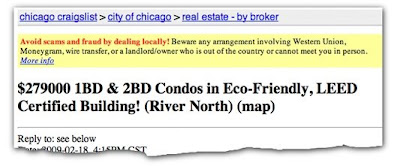The following was spurred by a recent NYTimes blog post about a craigslist post that found a developer who was advertising their "LEED Certified Building" before the certification was complete. From a risk management perspective, it seems to me like this wouldn't be much of a problem unless the building doesn't ultimately earn it's rating. In other words, I doubt the USGBC will be going around suing folks for jumping the gun early, but you can bet someone leasing or purchasing the building sure would if these promises aren't met.

Bad Broker! No Cookie for You!
I figure this is an important enough topic to warrant a post about what you can an can't say during various stages of the certification process, and what guidance the USGBC offers regarding logo usage and other related issues.
"LEED Certified" vs. "LEED Registered"
The only projects that can claim to be LEED Certified are those that have COMPLETELY finished the entire LEED certification process. This sounds obvious, but since it can take awhile for the paperwork to go through, many building owners will really want to start claiming this once the building opens or even before for sales and marketing purposes. It's worth making this clear to your client ahead of time. You don't have to wait for the plaque to arrive in the mail, but you do have to accept the final construction review.
The good news is that a building can claim to be "LEED Registered" the moment you register with LEED-Online and fork over the $450-600 that requires. For all practical purposes, I think just replacing calling a building LEED Registered instead of LEED Certified will carry as much cachet with the general public, so you can still talk up a building's green cred before it's completed. Our company has gone so far as to create a few examples of approved copy for projects pursuing certification but not yet finished, complete with all of the little legal characters:
As a first step toward LEED® Green Building Certification, [organization/owner] has registered this project with the U.S. Green Building Council. To achieve LEED certification, documentation demonstrating that the project has successfully met the sustainable design and performance criteria set forth within the LEED Green Building Rating SystemTM must be submitted, reviewed, and approved by USGBC. LEED® is a registered trademark of the U.S. Green Building Council.
Official accepted language from the USGBC can be found on page 21 of this guide.
LEED-CS Precertification
The USGBC foresaw an owners need to claim something about the sustainability of the building before it is complete, and as a result created a Percertification option for LEED-Core and Shell (LEED-CS) projects. I've been through this before, and I'm not sure I will recommend it again. The costs are relatively low, but it still does not allow you to claim the building is "Certified", only "Precertified", and in my mind you might as well just stick with "Registered" and save yourself the trouble.
Logos Aplenty
You might have noticed that the LEED brand is very important to the USGBC, and as such they provide official guidelines about what you may and may not do with their graphic materials and logos. All of this info is available here. There are important restrictions about how both the USGBC Member logo can be used on your company's marketing materials and how the LEED Certification logo can be used on marketing materials for a specific project.
Dangerzone!!! Claiming the Benefits of Sustainable Design
The most dangerous thing you can do is imply or outright state that the benefits studies are beginning to show about sustainable design in general apply specifically to your project. If someone moves in and does not find the same benefit you claimed, you could be in for some trouble. In general, I make a big effort to distance specific projects from the general benefits by making sure the studies in question (say, about reduced absenteeism due to better indoor air quality) are clearly credited to the people who performed the study and can not be attributed as a claim I have made about what's supposed to happen in this particular building.
It's also important to be careful about the claims you make as a result of energy modeling or water use reduction calculations. I've gone into some detail about this particular issue here.
Have you found yourself in a sticky situation involving marketing of LEED projects? Please share your experiences by leaving a comment!






